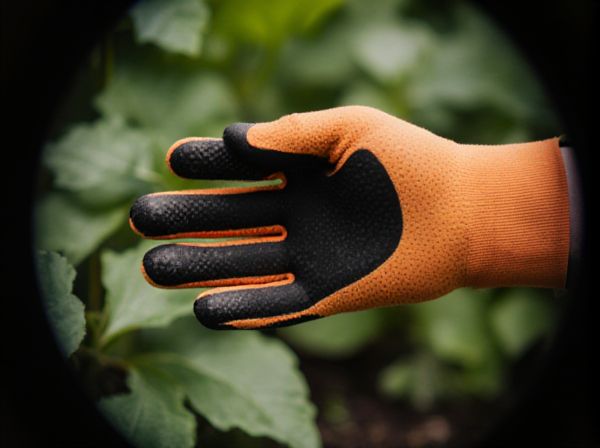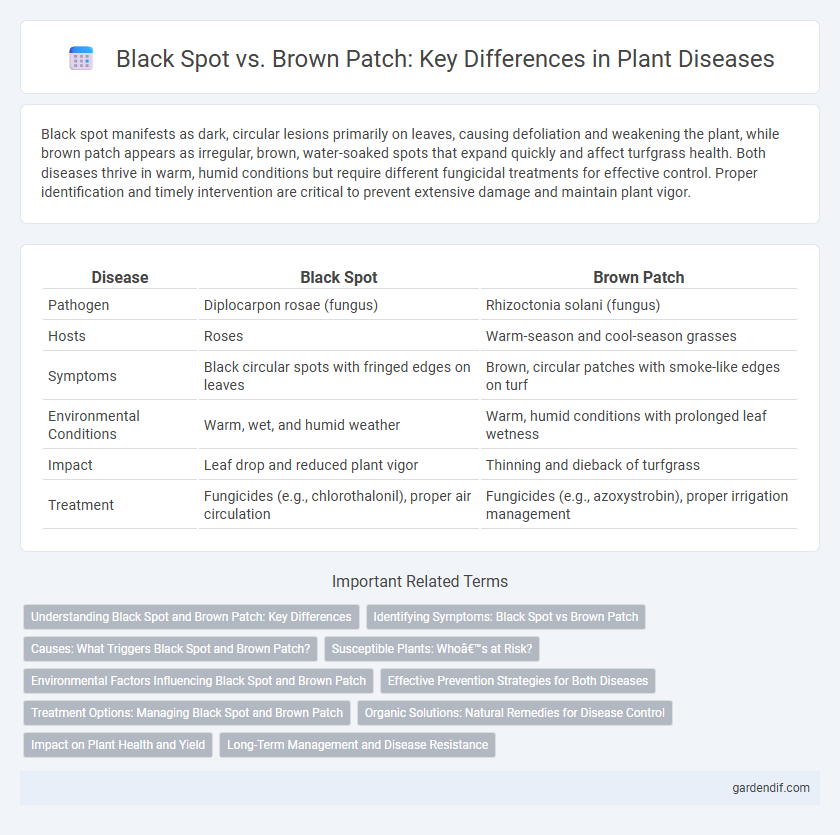
Black Spot vs Brown Patch Illustration
Black spot manifests as dark, circular lesions primarily on leaves, causing defoliation and weakening the plant, while brown patch appears as irregular, brown, water-soaked spots that expand quickly and affect turfgrass health. Both diseases thrive in warm, humid conditions but require different fungicidal treatments for effective control. Proper identification and timely intervention are critical to prevent extensive damage and maintain plant vigor.
Table of Comparison
| Disease | Black Spot | Brown Patch |
|---|---|---|
| Pathogen | Diplocarpon rosae (fungus) | Rhizoctonia solani (fungus) |
| Hosts | Roses | Warm-season and cool-season grasses |
| Symptoms | Black circular spots with fringed edges on leaves | Brown, circular patches with smoke-like edges on turf |
| Environmental Conditions | Warm, wet, and humid weather | Warm, humid conditions with prolonged leaf wetness |
| Impact | Leaf drop and reduced plant vigor | Thinning and dieback of turfgrass |
| Treatment | Fungicides (e.g., chlorothalonil), proper air circulation | Fungicides (e.g., azoxystrobin), proper irrigation management |
Understanding Black Spot and Brown Patch: Key Differences
Black Spot and Brown Patch are fungal diseases that affect turfgrass, but they differ significantly in their symptoms and environmental conditions. Black Spot causes small, black lesions primarily on leaf blades, thriving in cooler, humid conditions, while Brown Patch produces large, brown, circular patches under hot, wet weather. Accurate identification depends on recognizing these distinct patterns and environmental triggers to implement effective disease management strategies.
Identifying Symptoms: Black Spot vs Brown Patch
Black Spot disease presents as circular black lesions with fringed edges primarily on the upper surfaces of leaves, often accompanied by yellow halos. Brown Patch manifests as irregular, dark brown to tan patches with a distinct smoke ring on turfgrass, typically occurring in humid, warm conditions. Identifying symptoms involves noting lesion coloration, shape, location, and environmental factors to differentiate between these foliar diseases.
Causes: What Triggers Black Spot and Brown Patch?
Black Spot is primarily triggered by the fungal pathogen Diplocarpon rosae, which thrives in warm, wet conditions and spreads through water splashes or rain. Brown Patch is caused by the fungus Rhizoctonia solani, favoring hot, humid weather and poorly drained soils that promote continuous leaf wetness. Both diseases require specific environmental conditions like high moisture and temperature fluctuations to initiate infection and development.
Susceptible Plants: Who’s at Risk?
Black Spot primarily targets rose bushes, with susceptible varieties including hybrid teas, floribundas, and climbers, especially in humid climates conducive to fungal growth. Brown Patch predominantly affects cool-season grasses such as Kentucky bluegrass, tall fescue, and perennial ryegrass, thriving in warm, wet conditions. Understanding the specific plant hosts vulnerable to each disease aids in effective prevention and targeted treatment strategies.
Environmental Factors Influencing Black Spot and Brown Patch
Black Spot thrives in cool, moist environments with frequent leaf wetness, typically occurring during spring and fall when humidity is high and temperatures range between 60-80degF. Brown Patch favors warm, humid conditions with prolonged leaf wetness, commonly developing in summer when temperatures reach 80-95degF and turfgrass experiences nighttime dew or irrigation. Both diseases are exacerbated by poor air circulation and excessive nitrogen fertilization, leading to increased susceptibility in dense, shaded areas.
Effective Prevention Strategies for Both Diseases
Effective prevention strategies for Black Spot and Brown Patch diseases include maintaining proper lawn and plant care through regular watering practices that avoid leaf wetness and promote good air circulation. Utilizing resistant plant varieties and applying fungicides with active ingredients such as chlorothalonil or azoxystrobin at recommended intervals can significantly reduce infection rates. Implementing proper soil drainage and mowing at appropriate heights further minimizes stress on turfgrass and ornamental plants, enhancing overall disease resistance.
Treatment Options: Managing Black Spot and Brown Patch
Effective treatment of Black Spot involves the use of fungicides containing active ingredients like chlorothalonil, myclobutanil, or azoxystrobin, applied at regular intervals during humid conditions to inhibit fungal growth. Managing Brown Patch requires fungicides such as thiophanate-methyl, propiconazole, or azoxystrobin, combined with proper cultural practices like reducing nitrogen fertilization and improving air circulation to minimize disease severity. Both diseases benefit from maintaining appropriate mowing heights, improving drainage, and applying fungicides preventatively to achieve optimal turf health.
Organic Solutions: Natural Remedies for Disease Control
Black Spot and Brown Patch both affect turfgrass, causing significant damage, but can be managed effectively using organic solutions such as neem oil, compost tea, and beneficial microorganisms that enhance soil health and plant immunity. Incorporating organic mulches and maintaining proper air circulation reduces moisture buildup, thereby limiting fungal growth associated with these diseases. Regular application of biofungicides containing Bacillus subtilis provides a sustainable approach to suppressing pathogens while promoting a balanced ecosystem.
Impact on Plant Health and Yield
Black Spot primarily affects the leaves of plants, causing dark, circular lesions that lead to premature leaf drop and reduced photosynthesis, significantly diminishing overall plant vigor and crop yield. Brown Patch, caused by a fungal pathogen, results in large, brown, irregular patches on lawns or turfgrass, weakening root systems and increasing susceptibility to drought and nutrient stress, thereby lowering both aesthetic value and biomass production. Both diseases compromise plant health through tissue damage, but Black Spot mainly impairs foliage function while Brown Patch disrupts root and crown integrity, each reducing agricultural productivity in distinct ways.
Long-Term Management and Disease Resistance
Effective long-term management of Black Spot and Brown Patch diseases relies on implementing cultural practices such as proper irrigation, adequate air circulation, and regular mowing to reduce host susceptibility. Selecting disease-resistant turfgrass varieties specific to each pathogen--Rhodococcus species for Black Spot and Rhizoctonia solani for Brown Patch--significantly lowers disease incidence and severity. Integrated disease management combining resistant cultivars, targeted fungicide applications, and environmental modifications ensures sustainable control and minimizes pathogen development.
Black Spot vs Brown Patch Infographic

 gardendif.com
gardendif.com